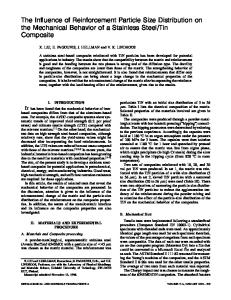The influence of matrix microstructure and particle reinforcement on the creep behavior of 2219 aluminum
- PDF / 3,729,306 Bytes
- 11 Pages / 597 x 774 pts Page_size
- 12 Downloads / 362 Views
I.
INTRODUCTION
T H E creep resistance of particle-reinforced aluminum composites, while inferior to similar alloys reinforced with whiskers or continuous fibers, is, nevertheless, an important property because of the potential use of these materials in elevated temperature applications. However, creep mechanisms and the influence of microstructural and reinforcement variables on creep are not completely understood at this time, and recent research, tL-"] summarized in Table I, has shown that the influence of adding ceramic reinforcement to aluminum alloys is not easily categorized. Some investigations have found that particle-reinforced composites have lower creep resistance than their unreinforced counterparts over a significant range of temperatures; t~] others have shown significant improvements in the creep resistance when particles are added to aluminum alloys. [2,7,11] It also has been suggested that a transition occurs in the creep behavior. [4] At low stresses, composite creep strengthening was observed, and at high stresses, the unreinforced matrix was more creep resistant than the counterpart composite. In materials where composite creep strengthening has been observed, the amount of strengthening is dependent on the nature of the reinforcement. In a pure aluminum composite reinforced with SiC particles, creep resistance has been found to increase with an increasing volume fraction and a decreasing particle size. 17] A number of investigations have suggested that particlereinforced alloys do not exhibit an extended steady-state region. [3-5,8,9] Rather, they suggest that creep transitions directly from primary to tertiary creep and that creep rates are best described by a minimum, rather than a steadystate, creep rate. Recent investigations in reinforced pure aluminum composites have shown that a steady-state creep P.E. KRAJEWSKI, Graduate Student, and J.W. JONES, Professor, are with the Department of Materials Science and Engineering, University of Michigan, Ann Arbor, MI 48109. J.E. ALLISON, Staff Scientist, is with the Materials Science Department, Ford Research Laboratory, Ford Motor Company, Dearborn, MI 48124. Manuscript submitted March 10, 1993. METALLURGICAL TRANSACTIONS A
region does in fact exist. L6] However, the extent of the steady-state region is dependent on stress level and whether tensile or compressive creep was studied. In addition, some authors who characterize these materials as exhibiting minimum creep have observed steady-state behavior at higher testing temperatures. [4,5] Regardless of the significance of steady-state creep in many of these previous studies, power law creep has been presumed and the reported stress exponents have ranged from 7.4 to 20 with the majority of studies observing values between 7.4 and 10. tz,4-m] These values are higher than is generally expected in unreinforced aluminum, t12] and considerable discussion of the role of reinforcement in elevating the stress dependence of creep rate has been offered. ]9] One factor which has hindered a complete unders
Data Loading...










